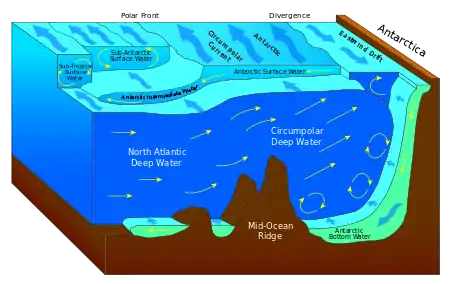Continental rise
The continental rise is a sediment underwater feature found between the continental slope and the abyssal plain. This feature can be found all around the world, and it represents the final stage in the boundary between continents and the deepest part of the ocean. The environment in the continental rise is quite unique, and many oceanographers study it extensively in the hopes of learning more about the ocean and geologic history.

At the bottom of the continental slope, one will find the continental rise, an underwater hill composed of tons of accumulated sediments.[1] The general slope of the continental rise is between 0.5 degrees and 1.0 degrees. Deposition of sediments at the mouth of submarine canyons may form enormous fan-shaped accumulations called submarine fans on both the continental slope and continental rise.[2] Beyond the continental rise stretches the abyssal plain, an extremely deep and flat area of the sea floor. The abyssal plain hosts many unique life forms which are uniquely adapted to survival in its cold, high pressure, and dark conditions. The flatness of the abyssal plain is interrupted by massive underwater mountain chains near the tectonic boundaries of the Earth's plates. The sediments are mostly sand and pieces of coral or rock.
References
- Burk, C.A.; Drake, C.L. The Geology of Continental Margins. Springer. p. 18.
- Deptuck, Mark E.; Sylvester, Zoltan (2017). "Submarine Fans and Their Channels, Levees, and Lobes". In Micallef, A.; Krastel, S.; Savini, A. (eds.). Springer Geology. Springer. doi:10.1007/978-3-319-57852-1_15. ISBN 978-3-319-57852-1.

